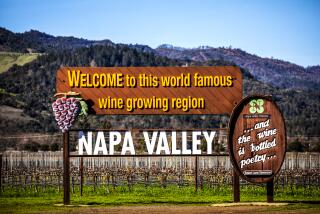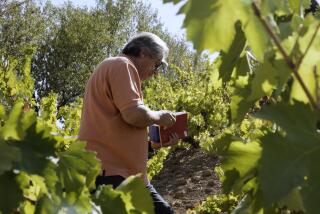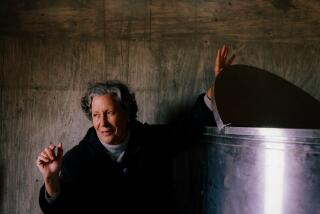The New Danube
A great wine you don’t know about is like an old masterpiece lying in someone else’s attic. Until it’s discovered, it might as well not exist.
This was long the fate in the U.S. of Austria’s great white wines. But since the early 1990s, they have been trickling into the country in small quantities, just enough to become conversation pieces among the wine cognoscenti. Now two winemaking teams from the Danube Valley are setting out to make them better known.
With tousled hair, three days of stubble on his lean face, a broad grin and an open-necked shirt, Austrian vintner Will Brundlmayer, 45, looks something like an intellectual Mickey Rourke. He may be too charming and witty to qualify as a Rourke-style “bad boy,” but he is no less a rebel for that.
“During the 15 years since I took over the family estate, I have rethought the wheel,” he says, half-seriously, half-jokingly. With their “lyre” trellising systems, his vineyards are certainly a radical break with Austrian tradition, and his state-of-the-art winery would not look out of place in California.
Most revolutionary, though, has been Brundlmayer’s willingness to get out into the world to present his wines. Austria’s top vintners have traditionally been stay-at-homes. Most of their wine estates are so small and produce so little wine that they have trouble just satisfying Austria’s own healthy demand for their wines. The result has been that, until recently, only Austrians knew how good their best dry whites are.
With 125 acres of vines around the town of Langenlois in the Kamptal region just north of the Danube Valley in Lower Austria, Brundlmayer had good reason to take a cosmopolitan approach to selling his wines; he makes several times as much wine as most of his leading colleagues. While Brundlmayer takes a quiet pride in running an efficient and successful business, it is pleasure in wine and an insatiable curiosity that drive him. It was curiosity that led him to develop a barrel-fermented Chardonnay and a methode-Champenoise sparkling wine that is a dead ringer for the sparkling wines produced in the Champagne region of France. Both are among the best Austrian examples of these wine styles, which are not traditional in Austria.
But it is his expressive and uncompromisingly Austrian-style dry whites from the native Riesling and Gruner Veltliner grapes that are remarkable. The finest of his Rieslings is the “Alte Reben” or “old vines” bottling from the Heiligenstein vineyard. The 1995 vintage is packed with ripe peach aromas and has a firm core of mineral flavors. The 1996 is less aromatic but vibrant and invigoratingly fresh. His regular bottlings of Riesling from the Heiligenstein are somewhat less intense but have the same general characteristics as the “Alte Reben” wines.
Brundlmayer’s boyish enthusiasm shows most strongly when he takes visitors out onto the narrow terraces that cover the steep slope of his prize vineyard and explains how he switched to organic cultivation in the early ‘80s. On a cloudless day, you quickly need to dispense with your jacket in this sun trap. The climb is worth it for the view, though, which stretches to the Danube six miles to the south and toward Vienna beyond the sinuous sliver of silver that marks its course.
The Gruner Veltliner grape, which accounts for 36% of Austria’s 135,000 acres of vines, usually gives medium-bodied dry whites with a peppery character ideal for everyday drinking. However, in the hands of a talented winemaker, it becomes a chameleon capable of giving many different styles of wine. Brundlmayer’s Gruner Veltliners range from feather lightness and delicacy to corpulence and unrestrained power.
Toward the lighter end of that scale is the elegant Berg Vogelsang Kabinett, whose subtle melon and spice character is matched with a refreshing acidity. Less easy to quaff is the opulent and massive Gruner Veltliner from the Lamm vineyard, which weighs in with anything from 13 1/2% to 15 1/2% alcohol, depending on the vintage. The monumental 1995 is powerful evidence for this grape’s capability for giving great wines.
This wine now has a challenger, and it comes from Brundlmayer’s own hand. The Schloss Gobelsburg estate, where he is also now responsible for vinification, has Gruner Veltliner vines planted in the Lamm site right next to the Brundlmayer family’s own.
In August 1996, Brundlmayer, together with partner Michael Moosbrugger, took a long-term lease on Gobelsburg’s 75 acres of vineyards from the owners, the nearby Stift Zwettl monastery. The move stunned many members of the Austrian wine trade. The estate had enjoyed an excellent reputation in the ‘60s and ‘70s, but quality had slipped badly.
However, the 1996 vintage wines silenced the doubters. Gobelsburg’s 1996 Gruner Veltliner from the Lamm site, a rich dry white which marries power, succulence and subtlety, was rightly acclaimed as one of the two or three best Gruner Veltliners of the vintage.
Only nine miles from Langenlois, close to the medieval town of Durnstein, another duo is undertaking an even greater transformation. With the 1995 vintage, marketing expert Willi Klinger, who helped build Wein & Co. into Austria’s leading chain of wine stores, and winemaker Fritz Miesbauer took control of the Freie Weingartner Wachau, or Free Vintners of the Wachau.
Their vineyard property, just under 1,400 acres, may sound small compared to the largest California wineries, but it is a huge operation next to most of Europe’s top wine estates. It represents 40% of the Wachau region’s total production.
Still, these numbers say nothing about the dynamism with which Klinger and Miesbauer have approached their task. The Freie Weingartner has enjoyed a good reputation virtually since its foundation in 1938, but during recent years the need for a new impulse became ever clearer to observers of the Austrian wine industry. Klinger, 41, looks like the answer--he’s a live wire, always bubbling over with new ideas. He has instigated an all-encompassing program called “Wachau 2010” designed to modernize all the Freie Weingartner’s existing facilities and to improve the quality of the grapes delivered to the press houses through precise planning of which varietal and which clone is planted in each parcel of vineyard.
Miesbauer, 29, has at least as much enthusiasm for his region’s wines as Klinger, but he is a more thoughtful and less impulsive personality. “When Willi Klinger arrived, I thought I would burn out within a month, but quickly we found that we balance and complement each other very well,” he says.
Miesbauer’s official title is winemaker, but his work begins among the vines. “Quality comes from the vineyard, and the quantity of excellent steep vineyards along the banks of the Danube our members tend gives us the potential to produce top wines in serious quantities,” Klinger says.
“The scale of our production presents us with a great logistical and technical challenge though,” he says. “‘Wachau 2010’s goal is to enable us to realize 100% of our potential by that date.”
The Freie Weingartner’s 1995 Riesling “Smaragd” (the Wachau designation for dry wines with a minimum of 12% alcohol) from the Singerriedel site tastes as if it is not far off that 100%. It is as sleek, muscular and elegant as a thoroughbred racehorse and can age for many years. The following year was a less spectacular vintage for Austria, and the 1996 version of this wine is correspondingly lighter-bodied, but it has delicate floral aromas and an appealing crispness. If you cannot find the ‘95s, the Riesling “Smaragd” from the Achleiten site is the fullest and best ’96 they made.
Miesbauer is extremely optimistic about the quality of the 1997 vintage currently maturing in large old wooden casks in the Freie Weingartner’s labyrinthine cellars. “The regular wines are already very charming and delightful, but also have some real character,” Miesbauer says. “The Riesling ‘Smaragd’ wines are packed with fruit and taste fantastic, while the Gruner Veltliner ‘Smaragd’ wines are rich and creamy, but need time to open up.”
Brundlmayer and Moosbrugger stand in friendly competition with Klinger and Miesbauer in more senses than one. Both teams can claim to have the most beautiful tasting rooms in Austria. Schloss Gobelsburg possesses arguably the oldest in all of Austria, the castle having been built in 1074 and remodeled in the Renaissance style during the 16th century. Many of the larger rooms were decorated in the baroque style during the 18th century after the monastery of Stift Zwettl purchased it.
The Kellerschlossel, a miniature castle which stands above the entrance to the cellars of the Freie Weingartner, is also Baroque, having been built by the famous architect Jakob Prandtauer in 1715. (Prandtauer was also responsible for the Stift Melk monastery at the western end of the Wachau.) At that time, the co-operative was a wine estate owned by the Earl of Starhemberg. The view from here over the Danube, the town of Durnstein and the precipitous terraces of the Kellerberg vineyard site looks as though it was laid out with the postcard industry in mind.
Tasting in either of these places may add an extra dimension to the experience of the estates’ wines, but fortunately, the journey is no longer essential. Through ambassadors such as these, Austrian wine’s long isolation is finally coming to an end, and the world is rapidly discovering that this country has wines as impressive as its scenery and cultural monuments.
(BEGIN TEXT OF INFOBOX / INFOGRAPHIC)
Sources
Austrian wines can still be hard to find in Southern California. There are two excellent mail-order sources, though. For Brundlmayer’s wines, call Bill Mayer at Age of Riesling in the Bay Area, (510) 549-2444. For the wines of Freie Weingartner, call Glenn Allen at Sam’s Wine Warehouse in Chicago, (312) 664-4394.


